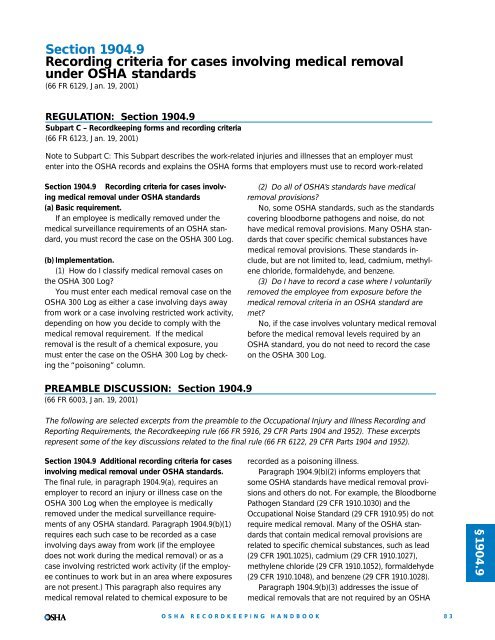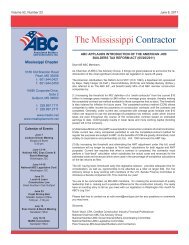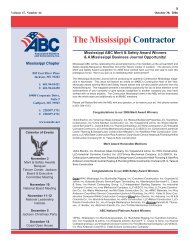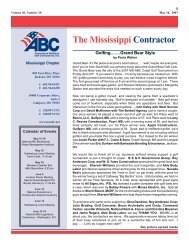OSHA Recordkeeping Handbook - Msabc.net
OSHA Recordkeeping Handbook - Msabc.net
OSHA Recordkeeping Handbook - Msabc.net
Create successful ePaper yourself
Turn your PDF publications into a flip-book with our unique Google optimized e-Paper software.
Section 1904.9Recording criteria for cases involving medical removalunder <strong>OSHA</strong> standards(66 FR 6129, Jan. 19, 2001)REGULATION: Section 1904.9Subpart C – <strong>Recordkeeping</strong> forms and recording criteria(66 FR 6123, Jan. 19, 2001)Note to Subpart C: This Subpart describes the work-related injuries and illnesses that an employer mustenter into the <strong>OSHA</strong> records and explains the <strong>OSHA</strong> forms that employers must use to record work-relatedSection 1904.9 Recording criteria for cases involvingmedical removal under <strong>OSHA</strong> standards(a) Basic requirement.If an employee is medically removed under themedical surveillance requirements of an <strong>OSHA</strong> standard,you must record the case on the <strong>OSHA</strong> 300 Log.(b) Implementation.(1) How do I classify medical removal cases onthe <strong>OSHA</strong> 300 Log?You must enter each medical removal case on the<strong>OSHA</strong> 300 Log as either a case involving days awayfrom work or a case involving restricted work activity,depending on how you decide to comply with themedical removal requirement. If the medicalremoval is the result of a chemical exposure, youmust enter the case on the <strong>OSHA</strong> 300 Log by checkingthe “poisoning” column.(2) Do all of <strong>OSHA</strong>’s standards have medicalremoval provisions?No, some <strong>OSHA</strong> standards, such as the standardscovering bloodborne pathogens and noise, do nothave medical removal provisions. Many <strong>OSHA</strong> standardsthat cover specific chemical substances havemedical removal provisions. These standards include,but are not limited to, lead, cadmium, methylenechloride, formaldehyde, and benzene.(3) Do I have to record a case where I voluntarilyremoved the employee from exposure before themedical removal criteria in an <strong>OSHA</strong> standard aremet?No, if the case involves voluntary medical removalbefore the medical removal levels required by an<strong>OSHA</strong> standard, you do not need to record the caseon the <strong>OSHA</strong> 300 Log.PREAMBLE DISCUSSION: Section 1904.9(66 FR 6003, Jan. 19, 2001)The following are selected excerpts from the preamble to the Occupational Injury and Illness Recording andReporting Requirements, the <strong>Recordkeeping</strong> rule (66 FR 5916, 29 CFR Parts 1904 and 1952). These excerptsrepresent some of the key discussions related to the final rule (66 FR 6122, 29 CFR Parts 1904 and 1952).Section 1904.9 Additional recording criteria for casesinvolving medical removal under <strong>OSHA</strong> standards.The final rule, in paragraph 1904.9(a), requires anemployer to record an injury or illness case on the<strong>OSHA</strong> 300 Log when the employee is medicallyremoved under the medical surveillance requirementsof any <strong>OSHA</strong> standard. Paragraph 1904.9(b)(1)requires each such case to be recorded as a caseinvolving days away from work (if the employeedoes not work during the medical removal) or as acase involving restricted work activity (if the employeecontinues to work but in an area where exposuresare not present.) This paragraph also requires anymedical removal related to chemical exposure to berecorded as a poisoning illness.Paragraph 1904.9(b)(2) informs employers thatsome <strong>OSHA</strong> standards have medical removal provisionsand others do not. For example, the BloodbornePathogen Standard (29 CFR 1910.1030) and theOccupational Noise Standard (29 CFR 1910.95) do notrequire medical removal. Many of the <strong>OSHA</strong> standardsthat contain medical removal provisions arerelated to specific chemical substances, such as lead(29 CFR 1901.1025), cadmium (29 CFR 1910.1027),methylene chloride (29 CFR 1910.1052), formaldehyde(29 CFR 1910.1048), and benzene (29 CFR 1910.1028).Paragraph 1904.9(b)(3) addresses the issue ofmedical removals that are not required by an <strong>OSHA</strong>§1904.9<strong>OSHA</strong> RECORDKEEPINGHANDBOOK83







